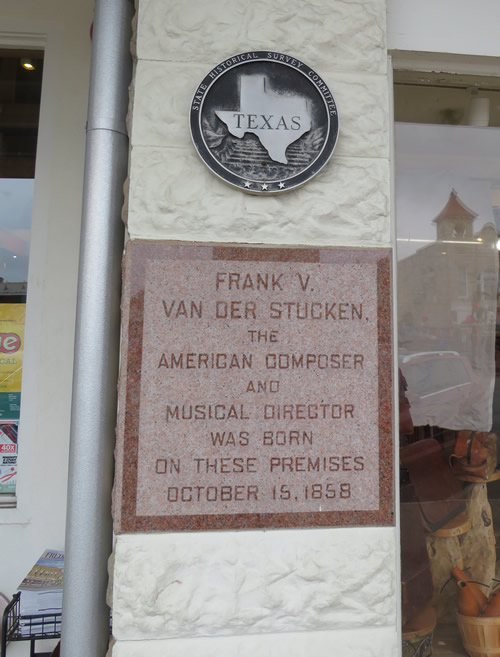Books by
Michael Barr
Order Here: |
|
| Frank
Van der Stucken is Fredericksburg's
least-known international celebrity. Many of us know his name but
are unfamiliar with his work. As a composer and conductor of classical
music, his compositions have a limited audience when compared to folk
and popular music. |
Portait of Frank
Van der Stucken
courtesy Gillespie County Historical Sociey |
Van der Stucken's
father, also named Frank, came to Texas from Antwerp, Belgium with
the French colonizer Henri
Castro. In 1852 he married Sophie Schoenewolf of Fredericksburg.
The elder Van der Stucken ran a store on Main Street in Fredericksburg.
When the Civil War broke out he got a contract as a freighter. Later
he was a captain in the Confederate Army and chief justice of Gillespie
County.-
His son, Frank Valentin Van der Stucken, was born in Fredericksburg
on October 15, 1858. The boy was baptized in the old Vereins
Kirche. |
The site where
Van der Stucken was born
Photo courtesy Michael
Barr, Feb. 2022 |
Frank Van der
Stucken's parents recognized his talent for music.at an early age.
The family moved back to Europe after the Civil War in part so young
Frank (he was probably 8 or 9 years old) could pursue a musical career,
there being little opportunity for classical training on the wild
Texas frontier.
When the family left for Europe, Frank's father deeded his house,
store and stable in Fredericksburg
to his father-in-law Valentin Hopf. Back in Antwerp the elder Van
der Stucken went into the milling business and made a fortune.
Meanwhile young Frank Van der Stucken studied music theory and composition
with Belgian composer Pierre Benoit. He began performing his own compositions
in public at age 16. He was one of the first American musicians properly
trained for the career of Kapellmeister (professional orchestral conductor).
Van der Stucken admired the German composer Richard Wagner, and his
compositions sometimes used texts from Goethe and other German writers.
Between 1878 and 1881 Van der Stucken traveled across Austria, Switzerland,
Italy and France. He hung out with Italian composer Giuseppe Verdi
in Paris. He married German singer Maria Vollmer in 1880. He met her
in Paris where she was a student.
In 1881 the Hungarian pianist, composer and conductor Franz Liszt
invited Van der Stucken to Weimar, and insisted the young man give
concerts of his own works.
In
1884 Van der Stucken came back to America to direct the Arion Society
- a famous New York men's choir. While in New York he conducted the
American premier of Brahms 3rd symphony. He helped organize the Northeast
German Saenger Bund, putting together spectacular concerts featuring
massive choirs of 4,000 to 5,000 voices.
He fought all his life for recognition of American musicians at home
and abroad. In New York City he conducted the first concert in this
country devoted exclusively to American composers. In 1889 he conducted
the first concert of American compositions in Europe at the Paris
World Exposition.
In1895 First Lady Helen Taft founded the Cincinnati Symphony Orchestra
and convinced Frank Van der Stucken to organize and direct it. He
held the job for the next 8 years.
In his spare time he led the Boston Symphony Orchestra, the Chicago
Symphony Orchestra and the New York Philharmonic as guest conductor.
He directed the Cincinnati May Music Fest from 1906 to 1912.The May
Fest featured the full Cincinnati Symphony Orchestra and a grand chorus
of several hundred voices. It grew out of the German Saengerfest.
By
the turn of the 20th century Frank Van der Stucken had carved a name
for himself as an internationally known composer and director. The
Indianapolis Journal (April 25, 1897) called him "one of the few
really great directors and conductors of the world," adding that he
was "an all-around conductor of extraordinary merit."
The Washington Evening Star (May 20, 1923) described his music
as ranging from "riots of color and emotion" to "tenderly poetic."
I listened to Frank Van der Stucken's music on YouTube and found it
a complex, mysterious and wonderful language. I don't speak it very
well, but I enjoy the way it makes me feel and admire the magic it
takes to create it. |
 |
The site where
Van der Stucken was born
Photo courtesy Michael
Barr, Feb. 2022 |
A bust of Van
der Stucken in the garden at Marketplatz in Fredericksburg
Photo courtesy Michael
Barr, Feb. 2022 |
Sources:
"For the May Festival," Indianapolis Journal, April 25, 1897.
"American Composers - Frank Van der Stucken," Washington Evening Star,
May 20, 1929.
"Frank Van der Stucken, Gillespie Native Eminent in the Musical World,"
Fredericksburg Standard, April 28, 1971. |
|
|
